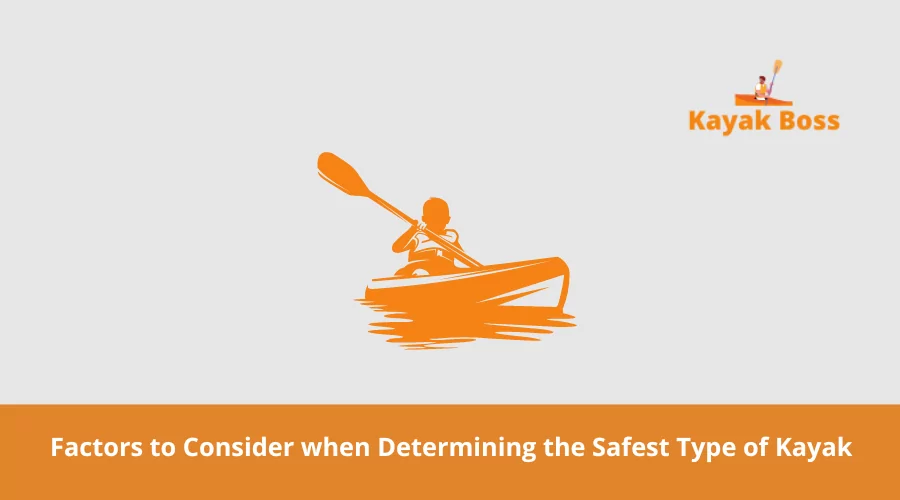Kayaking is a popular recreational activity enjoyed by people of all ages and skill levels. However, safety should always be a top priority when out on the water. The type of kayak you choose can greatly impact your safety while kayaking.
In this article, we will discuss what is the safest type of kayak? and The factors to consider when determining the safest type of kayak, and ultimately, the safest type of kayak for you to use.
Types of Kayaks
There are several different types of kayaks available on the market, each with its own unique characteristics and benefits. The three main types of kayaks are sit-in kayaks, sit-on-top kayaks, and inflatable kayaks.
Sit-in kayaks are the most traditional type of kayak. They are characterized by a cockpit that the user sits in, which is typically covered by a spray skirt to keep water out. These kayaks offer more protection from the elements and can be more stable than other types of kayaks.
Sit-on-top kayaks are characterized by an open deck that the user sits on. These kayaks are popular for recreational use and are often used for activities such as fishing and snorkeling. They offer more freedom of movement than sit-in kayaks and are easy to get in and out of.
Inflatable kayaks are made from durable materials such as PVC or nylon and are designed to be inflated before use. They are lightweight and easy to transport, making them a popular choice for camping and backpacking trips. They also have self-draining and self-bailing features which makes them safer in case of a capsize.
Each of these types of kayak has its own unique benefits and it’s important to consider what type of kayaking you plan to do and your personal preferences when choosing the right kayak for you.
Factors to Consider when Determining the Safest Type of Kayak

When determining the safest type of kayak, there are several factors to consider. These include:
Stability
A kayak that is stable and easy to maneuver is less likely to tip over or capsize. Sit-in kayaks are generally considered to be more stable than sit-on-top kayaks, but inflatable kayaks can also provide a high level of stability.
Durability
A kayak that is made from high-quality, durable materials is less likely to break or malfunction while out on the water. Inflatable kayaks are known to be durable and can withstand heavy use.
Ease of use
A kayak that is easy to control and maneuver is less likely to cause accidents or injuries. Sit-on-top kayaks are generally considered to be easier to use than sit-in kayaks.
Visibility
A kayak that is brightly colored or has reflective material is more likely to be seen by other boaters, which can help to prevent collisions. Sit-in kayaks typically offer greater visibility than sit-on-top kayaks.
Safety features
Kayaks with added safety features such as self-draining and self-bailing features, grab handles, or footrests can also help to increase safety while kayaking.
It’s important to remember that no matter what type of kayak you choose, proper training and equipment are essential to ensuring your safety while kayaking.
The Safest Type of Kayak

When it comes to determining the safest type of kayak, both sit-in kayaks and inflatable kayaks can be considered safe options.
Sit-in kayaks offer enhanced stability and protection from the elements, making them less likely to tip over or capsize. Additionally, they typically offer greater visibility, which can help to prevent collisions with other boats.
Inflatable kayaks are durable and easy to transport, making them a popular choice for camping and backpacking trips. They also have self-draining and self-bailing features, which can help to prevent capsizing and make it easier for the user to safely exit the kayak in the event of a capsize.
Ultimately, the safest type of kayak for you will depend on your personal preferences and the type of kayaking you plan to do. It’s important to consider the factors mentioned above, such as stability, durability, ease of use, visibility, and safety features when choosing the right kayak for you.
FAQ
Q: What is the safest type of kayak?
A: Both sit-in kayaks and inflatable kayaks can be considered safe options. Sit-in kayaks offer enhanced stability and protection from the elements, making them less likely to tip over or capsize.
Additionally, they typically offer greater visibility, which can help to prevent collisions with other boats. Inflatable kayaks are durable, easy to transport, and have self-draining and self-bailing features, which can help to prevent capsizing and make it easier for the user to safely exit the kayak in the event of a capsize.
Q: What factors should I consider when choosing a kayak for safety?
A: When choosing a kayak for safety, you should consider factors such as stability, durability, ease of use, visibility, and safety features.
A kayak that is stable and easy to maneuver is less likely to tip over or capsize. A kayak that is made from high-quality, durable materials is less likely to break or malfunction while out on the water.
A kayak that is easy to control and maneuver is less likely to cause accidents or injuries. A kayak that is brightly colored or has reflective material is more likely to be seen by other boaters, which can help to prevent collisions.
Q: Can sit-on-top kayaks be considered safe?
A: Sit-on-top kayaks can be considered safe, but they generally offer less stability and visibility compared to sit-in kayaks. They are easy to get in and out of, but are more prone to capsizing than sit-in kayaks. They are more suitable for recreational activities like fishing and snorkeling.
Q: Is training necessary for kayaking safety?
A: Yes, proper training is essential for kayaking safety. It is important to learn how to properly handle and maneuver your kayak, how to navigate safely in various water conditions, and how to respond in emergency situations.
Q: What equipment is necessary for kayaking safety?
A: Proper safety equipment includes a personal flotation device (PFD), a whistle or other signaling device, and a means of communication such as a cell phone or VHF radio.
Additionally, it is important to have appropriate clothing and gear for the weather conditions you will be kayaking in and to make sure your kayak is properly maintained and equipped with the necessary safety features.
Conclusion
Choosing the safest type of kayak is an important decision that should not be taken lightly. The key factors to consider when determining the safest type of kayak are stability, durability, ease of use, visibility, and safety features.
Sit-in kayaks offer enhanced stability and protection from the elements, making them less likely to tip over or capsize. They also offer greater visibility which can help to prevent collisions with other boats.
Inflatable kayaks are durable and easy to transport, making them a popular choice for camping and backpacking trips. They also have self-draining and self-bailing features, which can help to prevent capsizing and make it easier for the user to safely exit the kayak in the event of a capsize.
Ultimately, the safest type of kayak for you will depend on your personal preferences and the type of kayaking you plan to do. It’s important to remember that no matter what type of kayak you choose, proper training and equipment are essential to ensuring your safety while kayaking.
